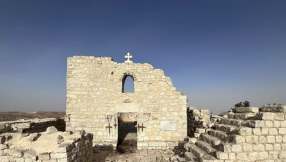FEATURE - America's Churches Find Financial Transparency
Many now have come to resemble corporations in their structure, with chief financial officers, lines of credit for expansion projects, and some very large income statements.
"The Bible speaks about money as much as any other topic and so we feel we need to communicate about money or anything financial on a regular basis," said Tim Tracey, Executive Director of Operations at Northland, a megachurch with 12,000 regular worshipers in Longwood, Florida.
"The money that supports a church comes from the congregation and so they need to be informed completely. It's not the leadership's money, it's ultimately God's money," he told Reuters in a telephone interview.
Tracey's church, which is headed by influential evangelical pastor Joel Hunter, publishes a weekly stewardship report on its Web site giving details of its finances, complete with pie charts showing how tithes are being utilised.
It is also in the process of signing up to the Evangelical Council for Financial Accountability (ECFA), which holds churches to stringent standards of accounting and transparency that are almost on a par with publicly listed companies.
"Any church that signs up with us as a member must commit to give their most recent audited financial report to anyone who asks, friend, foe or journalist. And they must commit to an independent audit," said ECFA vice-president Dan Busby.
He said the ECFA started almost three decades ago and its need became increasingly apparent with the eruption in the late 1980s of the financial scandals that toppled televangelist Jim Bakker.
While conservative U.S. evangelicals have nothing against wealth and success, many church leaders today do not want to be seen leading the lavish lifestyle that Bakker and his recently deceased ex-wife Tammy Faye led, complete with luxury cars, jewels, furs and an air-conditioned doghouse.
The ECFA has around 2,000 members, most of them groups such as missionary organizations affiliated with churches.
However, it does have almost 100 individual churches that have signed on and their combined annual revenues are around $600 million.
"Megachurches" are loosely defined as those with at least 2,000 regular attendees and have drawn a lot of the attention on this issue. But congregations large and small are starting to preach the gospel of accountability.
"The trend with us is more with the larger churches because we have always required an independent CPA (Certified Public Accountant) audit which is costly for smaller churches.
"But we do have one with an annual revenue of only $461,000 so even smaller churches see the importance," Busby said.
INCOME STATEMENT ON DEMAND
One of the ECFA's biggest members is the Illinois-based Willow Creek Community Church, which draws 21,000 regular weekend worshipers to its main headquarters and a few smaller regional affiliates.
Its CFO, Brian McAuliffe, willingly released a copy of its latest audited financial statement -- in keeping with ECFA standards.
Its combined financial statement for 2006 and 2005 details investments and assets held for endowment (over $12.6 million in money market funds, certificates of deposit and government securities -- safe, conservative investments).
Revenue in 2006 included almost $37 million from contributions alone with a total flow of over $45 million.
Expenses show where the money went, with $22 million being spent on worship and programming, which includes staff and operating costs for services plus amortization for buildings and equipment.
"If you look at the size of this church and its complexity you see the need for this approach," McAuliffe said.
Indeed, churches that choose to eschew openness can find themselves in hot water with members eager to keep a handle on how their donations are spent.
In Kansas, the evangelical First Family Church, which has about 5,000 members, has seen some members and employees leave because of questions about a lack of financial transparency and an appearance of lavish spending on homes, trips and cars by senior pastor Jerry Johnston.
The church's failure to comply with the ECFA standards also led a leading Christian radio network in July to drop the Rev. Johnston's daily program from its lineup.
Finding transparency has paid off for troubled churches.
In the town of Euless, north of Dallas, the huge First Bapist Church was found to be insolvent in October of 2004.
Administrative pastor Gary Phillips said one of the first reforms he introduced was accountability.
"We began to communicate weekly to the members what the financial conditions were," he said.
"Once the people were confident that their money was going where they intended it to go they began to respond by giving at a whole different level," he said.
As a result the 9,000-member church managed to pay off a $6.5 million debt in 30 months and get back in the black.













